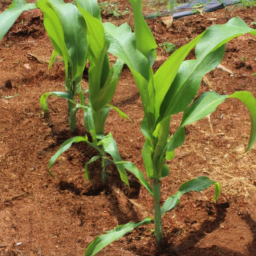How To Grow Corn Small Garden
Table of Contents []
How To Grow Corn In A Small Garden
Introduction
Growing corn in a small garden can be easy and rewarding! If you have the right space, growing corn can be doable even in a small garden. This article will provide guidance on how to approach growing corn in a limited area, and discuss the key elements of the process along with providing practical tips for a successful corn harvest.
Seed Selection
The first step is selecting the right seed for your home-grown corn. There are various seed varieties of corn to choose from and, and selecting the best seed for your plot of land is critical for a successful harvest. Depending on your space restrictions, corn seed maturing in different time frames can be chosen, such as early season, full season, or late-season. Keep in mind the size of the mature corn to ensure it can be grown successfully in the area available.
Soil Preparation
Second step is to prepare the soil in your garden correctly and effectively for the corn to grow. Make sure the soil is properly started, and pay special attention to besie injectational organism to increase the amount of nutrients in the soil. To get the best yield for your corn it is important to ensure the soil pH is below 7 and that the soil is well aerated. Adding organic materials such as compost or manure can help improve the soil structure and maximize the nutrients it can offer the corn plants.
Planting
The next step is actually planting the corn. Depending on the variety of corn that is chosen, the variety can be planted either close together or in rows. When planning a planting system in a small garden, it is best to plant in rows, with the plants spaced 3 to 6 inches apart. When planting in rows, it is important to ensure that the rows are wide enough apart to allow for easy tending, weeding and harvesting.
Water & Nutrients
Caring for the plants after they are planted is essential for a successful harvest. Corn should be watered regularly, as it is a high water user. When watering, make sure the soil is consistently moist. Watering at the roots of the plant is also important for getting the water to where the plants need it most. In addition to water, the plants will need the right nutrients to grow successfully. The addition of nitrogen, phosphorus and potassium in the soil can help promote growth.
Weeding & Pest Control
Weeds compete with the young plants for moisture, nutrients and light, so it is important to weed regularly and consistently. Hand weeding is the most effective means of removal. As for pest control, the best defense against pests is a healthy, well-nourished and balanced ecosystem. The addition of beneficial insects can help in controlling the number of pests, and organic techniques such as crop rotation and interplanting can also help reduce the presence of pests.
Harvest
The final step is harvest. Corn typically matures between 60 and 100 days after germination, with some varieties taking longer. In order to determine when your corn is ready for harvest, look at the tassels at the top of the stalks. When the tassels have turned brown and the kernels are soft and milky when punctured with a fingernail, the corn is ready for harvest.
Summary
Growing corn in a small garden can be an easy and rewarding task. Seed selection, proper soil preparation, planting, water and nutrient application, weed and pest control, and harvest are the main steps necessary for a successful corn harvest. With the right knowledge and dedication, it's possible to achieve a plentiful bounty of corn from the convenience of your small garden.

Previous Page
Next Page
